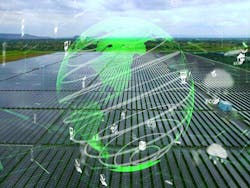A less obvious way the climate bill will help microgrids
Microgrid costs are likely to fall due to the Inflation Reduction Act, but that’s only one factor that promises to drive up demand for microgrids, should the climate bill pass the House as expected.
The second reason has to do with how the new law will accelerate the growth of renewable energy.
Microgrids are increasingly viewed as a technology primed to help the grid manage renewable intermittency since they can quickly respond when the grid needs more resources.
And if there is one thing the new climate legislation offers is a path to more renewable energy.
Abigail Ross Hopper, president and CEO of the Solar Energy Industries Association, summed up what the act means to the renewable energy industry when she described it as “the most transformational investment America has ever made in our climate future.”
Renewables need pick-me-up
“The solar industry has set a goal to account for 30% of all US electricity generation by 2030, and this legislation will be a catalyst for reaching that target,” she said.
And it comes at a time when renewable energy needs a pick-me-up in the US. American Clean Power recently reported weak second quarter performance for the industry. The trade organization blamed policy uncertainty, the economy, and trade issues for a 55% decline in project installations from the same period in 2021. In fact, the second quarter was the lowest quarter since the third quarter of 2019, according to the organization.
Credit American Clean Power
For China, another story
This comes despite a rosier investment picture globally, driven by China, according to BloombergNEF (BNEF). The first six months of 2022 produced a record-breaking $226 billion investment in renewables worldwide, up 33% from the first half of 2021, according to the BNEF’s most recent Renewable Energy Investment Tracker.
China invested $98 billion in the first half, up 128% compared to the same period in 2021, while the US secured $12 billion.
“Green infrastructure is the most important investment area that China is relying on to boost its weak economy in the second half of 2022, said Nannan Kou, BNEF’s head of China analysis.
A key way the climate bill helps the US get back in the game is by extending tax credits for 10 years, offering the industry market certainty, a significant plus according to various analyses. The industry has historically faced boom and bust cycles driven by the expiration — or even threat of expiration — of the tax credits.
Equally important, economist Noah Smith points out that the tax credits offer the opportunity to create a kind of virtual development cycle for renewables.
In “Why renewable subsidies are better than carbon taxes,” he argues that had the US pursued a climate tax instead, prices for petroleum products would have dropped along with falling demand, which would drive China and India back to those resources. But pursuing renewable tax credits “will continue driving the prices of these technologies down, and give all the countries of the world an incentive to adopt all of these things at an accelerated pace — which will in turn drive down prices even more,” he wrote.
If the Inflation Reduction Act becomes law, as expected…
While microgrid development is occurring throughout the US, it is heavily focused now where grid reliability is low and energy prices are high. If the Inflation Reduction Act becomes law, as expected, and if it then boosts renewable energy development, as expected, the microgrid industry may want to also train its eyes closely on areas of the US with high renewable energy penetration.
Track news about renewable energy and microgrids. Subscribe to the free Microgrid Knowledge Newsletter.
About the Author
Elisa Wood
Editor-in-Chief
Elisa Wood is the editor and founder of EnergyChangemakers.com. She is co-founder and former editor of Microgrid Knowledge.
